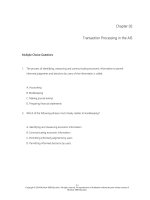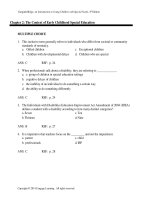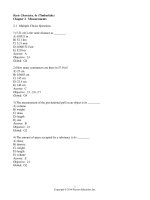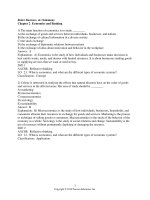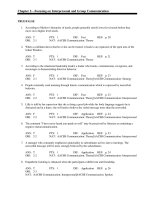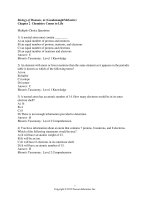Macroeconomics 4th edition hubbard test bank
Bạn đang xem bản rút gọn của tài liệu. Xem và tải ngay bản đầy đủ của tài liệu tại đây (509.32 KB, 65 trang )
Macroeconomics, 4e (Hubbard/O'Brien)
Chapter 2 Trade-offs, Comparative Advantage, and the Market System
2.1 Production Possibilities Frontiers and Opportunity Costs
1) Scarcity
A) stems from the incompatibility between limited resources and unlimited wants.
B) can be overcome by discovering new resources.
C) can be eliminated by rationing products.
D) is a bigger problem in market economies than in socialist economies.
Answer: A
Diff: 2 Page Ref: 40/40
Topic: Scarcity
*: Recurring
Learning Outcome: Micro 1: Identify the basic principles of economics and explain how to think
like an economist
AACSB: Reflective Thinking
Special Feature: None
2) BMW recently decided to build a manufacturing plant in Shenyang, China. At this plant,
BMW is able to take advantage of paying lower wages to its Chinese workers than it pays its
German workers, but it also sacrifices the high levels of technical training possessed by its
German workers. In deciding to open the Shenyang plant, BMW
A) faced no trade-offs because employing lower-wage workers increased efficiency.
B) faced a trade-off between higher cost and lower precision.
C) adopted a negative technological change because it replaced high-skilled workers with lowskilled workers.
D) eroded some of its competitiveness in the luxury car market because of its decreased cost of
production.
Answer: B
Diff: 2 Page Ref: 39/39
Topic: Opportunity Cost
Learning Outcome: Micro 3: Discuss different types of market system and the gains that can be
made from trade
AACSB: Analytic Skills
Special Feature: Chapter Opener: Managers Making Choices at BMW
1
Copyright © 2013 Pearson Education, Inc.
3) The principle of opportunity cost is that
A) in a market economy, taking advantage of profitable opportunities involves some money cost.
B) the economic cost of using a factor of production is the alternative use of that factor that is
given up.
C) taking advantage of investment opportunities involves costs.
D) the cost of production varies depending on the opportunity for technological application.
Answer: B
Diff: 3 Page Ref: 41/41
Topic: Opportunity Cost
*: Recurring
Learning Outcome: Micro 1: Identify the basic principles of economics and explain how to think
like an economist
AACSB: Reflective Thinking
Special Feature: None
4) The production possibilities frontier shows the ________ combinations of two products that
may be produced in a particular time period with available resources.
A) minimum attainable
B) maximum attainable
C) only
D) equitable
Answer: B
Diff: 2 Page Ref: 40/40
Topic: Production Possibilities Frontiers
*: Recurring
Learning Outcome: Micro 3: Discuss different types of market system and the gains that can be
made from trade
AACSB: Reflective Thinking
Special Feature: None
5) The production possibilities frontier model shows that
A) if consumers decide to buy more of a product its price will increase.
B) a market economy is more efficient in producing goods and services than is a centrally
planned economy.
C) economic growth can only be achieved by free market economies.
D) if all resources are fully and efficiently utilized, more of one good can be produced only by
producing less of another good.
Answer: D
Diff: 2 Page Ref: 40/40
Topic: Production Possibilities Frontiers
*: Recurring
Learning Outcome: Micro 3: Discuss different types of market system and the gains that can be
made from trade
AACSB: Analytic Skills
Special Feature: None
2
Copyright © 2013 Pearson Education, Inc.
6) The production possibilities frontier model assumes which of the following?
A) Labor, capital, land and natural resources are unlimited in quantity.
B) The economy produces only two products.
C) Any level of the two products that the economy produces is currently possible.
D) The level of technology is variable.
Answer: B
Diff: 2 Page Ref: 40/40
Topic: Production Possibilities Frontiers
*: Recurring
Learning Outcome: Micro 3: Discuss different types of market system and the gains that can be
made from trade
AACSB: Reflective Thinking
Special Feature: None
7) The attainable production points on a production possibility curve are
A) the horizontal and vertical intercepts.
B) the points along the production possibilities frontier.
C) the points outside the area enclosed by the production possibilities frontier.
D) the points along and inside the production possibility frontier.
Answer: D
Diff: 2 Page Ref: 40/40
Topic: Production Possibilities Frontiers
*: Recurring
Learning Outcome: Micro 3: Discuss different types of market system and the gains that can be
made from trade
AACSB: Reflective Thinking
Special Feature: None
8) The points outside the production possibilities frontier are
A) efficient.
B) attainable.
C) inefficient.
D) unattainable.
Answer: D
Diff: 2 Page Ref: 41/41
Topic: Production Possibilities Frontiers
*: Recurring
Learning Outcome: Micro 3: Discuss different types of market system and the gains that can be
made from trade
AACSB: Reflective Thinking
Special Feature: None
3
Copyright © 2013 Pearson Education, Inc.
Figure 2-1
9) Refer to Figure 2-1. Point A is
A) technically efficient.
B) unattainable with current resources.
C) inefficient in that not all resources are being used.
D) the equilibrium output combination.
Answer: C
Diff: 1 Page Ref: 41/41
Topic: Production Possibilities Frontiers
*: Recurring
Learning Outcome: Micro 2: Interpret and analyze information presented in different types of
graphs
AACSB: Reflective Thinking
Special Feature: None
10) Refer to Figure 2-1. Point B is
A) technically efficient.
B) unattainable with current resources.
C) inefficient in that not all resources are being used.
D) the equilibrium output combination.
Answer: A
Diff: 1 Page Ref: 41/41
Topic: Production Possibilities Frontiers
*: Recurring
Learning Outcome: Micro 2: Interpret and analyze information presented in different types of
graphs
AACSB: Reflective Thinking
Special Feature: None
4
Copyright © 2013 Pearson Education, Inc.
11) Refer to Figure 2-1. Point C is
A) technically efficient.
B) unattainable with current resources.
C) inefficient in that not all resources are being used.
D) is the equilibrium output combination.
Answer: B
Diff: 1 Page Ref: 41/41
Topic: Production Possibilities Frontiers
*: Recurring
Learning Outcome: Micro 2: Interpret and analyze information presented in different types of
graphs
AACSB: Reflective Thinking
Special Feature: None
12) In a production possibilities frontier model, a point ________ the frontier is productively
inefficient.
A) along
B) inside
C) outside
D) at either intercept of
Answer: B
Diff: 1 Page Ref: 41/41
Topic: Production Possibilities Frontiers
*: Recurring
Learning Outcome: Micro 3: Discuss different types of market system and the gains that can be
made from trade
AACSB: Reflective Thinking
Special Feature: None
13) Bella can produce either a combination of 60 silk roses and 80 silk leaves or a combination
of 70 silk roses and 55 silk leaves. If she now produces 60 silk roses and 80 silk leaves, what is
the opportunity cost of producing an additional 10 silk roses?
A) 2.5 silk leaves
B) 10 silk leaves
C) 25 silk leaves
D) 55 silk leaves
Answer: C
Diff: 2 Page Ref: 41/41
Topic: Opportunity Cost
*: Recurring
Learning Outcome: Micro 3: Discuss different types of market system and the gains that can be
made from trade
AACSB: Analytic Skills
Special Feature: None
5
Copyright © 2013 Pearson Education, Inc.
14) If the production possibilities frontier is ________, then opportunity costs are constant as
more of one good is produced.
A) bowed out
B) bowed in
C) non-linear
D) linear
Answer: D
Diff: 2 Page Ref: 41/41
Topic: Opportunity Cost
*: Recurring
Learning Outcome: Micro 3: Discuss different types of market system and the gains that can be
made from trade
AACSB: Reflective Thinking
Special Feature: None
Figure 2-2
Figure 2-2 above shows the production possibilities frontier for Mendonca, an agrarian nation
that produces two goods, meat and vegetables.
6
Copyright © 2013 Pearson Education, Inc.
15) Refer to Figure 2-2. What is the opportunity cost of one pound of vegetables?
3
A) pound of meat
4
B) 1.2 pounds of meat
1
C) 1 pounds of meat
3
D) 12 pounds of meat
Answer: A
Diff: 2 Page Ref: 42-43/42-43
Topic: Opportunity Cost
Learning Outcome: Micro 2: Interpret and analyze information presented in different types of
graphs
AACSB: Analytic Skills
Special Feature: Solved Problem: Drawing a Production Possibilities Frontier for Rosie's Boston
Bakery
16) Refer to Figure 2-2. What is the opportunity cost of one pound of meat?
3
A)
pound of vegetables
4
1
B) 1 pounds of vegetables
3
C) 1.6 pounds of vegetables
D) 16 pounds of vegetables
Answer: B
Diff: 2 Page Ref: 42-43/42-43
Topic: Opportunity Cost
Learning Outcome: Micro 2: Interpret and analyze information presented in different types of
graphs
AACSB: Analytic Skills
Special Feature: Solved Problem: Drawing a Production Possibilities Frontier for Rosie's Boston
Bakery
17) Refer to Figure 2-2. Suppose Mendonca is currently producing 60 pounds of vegetables per
period. How much meat is it also producing, assuming that resources are fully utilized?
A) 45 pounds of meat
B) 75 pounds of meat
C) 80 pounds of meat
D) 100 pounds of meat
Answer: B
Diff: 2 Page Ref: 42-43/42-43
Topic: Opportunity Cost
Learning Outcome: Micro 2: Interpret and analyze information presented in different types of
graphs
AACSB: Analytic Skills
Special Feature: Solved Problem: Drawing a Production Possibilities Frontier for Rosie's Boston
Bakery
7
Copyright © 2013 Pearson Education, Inc.
18) Refer to Figure 2-2. The linear production possibilities frontier in the figure indicates that
A) Mendonca has a comparative advantage in the production of vegetables.
B) Mendonca has a comparative disadvantage in the production of meat.
C) the tradeoff between meat and vegetables is constant.
D) it is progressively more expensive to produce meat.
Answer: C
Diff: 2 Page Ref: 42-43/42-43
Topic: Opportunity Cost
Learning Outcome: Micro 2: Interpret and analyze information presented in different types of
graphs
AACSB: Analytic Skills
Special Feature: Solved Problem: Drawing a Production Possibilities Frontier for Rosie's Boston
Bakery
19) A production possibilities frontier with a bowed outward shape indicates
A) the possibility of inefficient production.
B) constant opportunity costs as more and more of one good is produced.
C) increasing opportunity costs as more and more of one good is produced.
D) decreasing opportunity costs as more and more of one good is produced.
Answer: C
Diff: 2 Page Ref: 44/44
Topic: Opportunity Cost
*: Recurring
Learning Outcome: Micro 3: Discuss different types of market system and the gains that can be
made from trade
AACSB: Reflective Thinking
Special Feature: None
20) Increasing opportunity cost is represented by a ________ production possibilities frontier.
A) linear
B) bowed in
C) bowed out
D) vertical
Answer: C
Diff: 2 Page Ref: 44/44
Topic: Opportunity Cost
*: Recurring
Learning Outcome: Micro 3: Discuss different types of market system and the gains that can be
made from trade
AACSB: Reflective Thinking
Special Feature: None
8
Copyright © 2013 Pearson Education, Inc.
21) The slope of a production possibilities frontier
A) has no economic relevance or meaning.
B) is always constant.
C) is always varying.
D) measures the opportunity cost of producing one more unit of a good.
Answer: D
Diff: 1 Page Ref: 44/44
Topic: Opportunity Cost
*: Recurring
Learning Outcome: Micro 3: Discuss different types of market system and the gains that can be
made from trade
AACSB: Reflective Thinking
Special Feature: None
22) ________ marginal opportunity cost implies that the more resources already devoted to any
activity, the payoff from allocating yet more resources to that activity increases by progressively
smaller amounts.
A) Increasing
B) Decreasing
C) Constant
D) Negative
Answer: A
Diff: 2 Page Ref: 44/44
Topic: Opportunity Cost
*: Recurring
Learning Outcome: Micro 20: Apply the concepts of opportunity cost, marginal analysis, and
present value to make decisions
AACSB: Reflective Thinking
Special Feature: None
23) If opportunity costs are constant, the production possibilities frontier would be graphed as
A) a ray from the origin.
B) a positively sloped straight line.
C) a negatively sloped curve bowed in toward the origin.
D) a negatively sloped straight line.
Answer: D
Diff: 1 Page Ref: 44/44
Topic: Opportunity Cost
*: Recurring
Learning Outcome: Micro 3: Discuss different types of market system and the gains that can be
made from trade
AACSB: Reflective Thinking
Special Feature: None
9
Copyright © 2013 Pearson Education, Inc.
Figure 2-3
24) Refer to Figure 2-3. Sergio Vignetto raises cattle and llamas on his land. His land is equally
suitable for raising either animal. Which of the graphs in Figure 2-3 represent his production
possibilities frontier?
A) Graph A
B) Graph B
C) Graph C
D) either Graph A or Graph C
E) either Graph B or Graph C
Answer: A
Diff: 2 Page Ref: 44/44
Topic: Opportunity Cost
*: Recurring
Learning Outcome: Micro 2: Interpret and analyze information presented in different types of
graphs
AACSB: Reflective Thinking
Special Feature: None
25) Refer to Figure 2-3. Sergio Vignetto raises cattle and llamas on his land. A portion of his
land is more suitable for raising cattle, and the other portion is better suited for raising llamas.
Which of the graphs in Figure 2-3 represent his production possibilities frontier?
A) Graph A
B) Graph B
C) Graph C
D) either Graph A or Graph C
E) either Graph B or Graph C
Answer: C
Diff: 2 Page Ref: 44/44
Topic: Opportunity Cost
*: Recurring
Learning Outcome: Micro 2: Interpret and analyze information presented in different types of
graphs
AACSB: Reflective Thinking
Special Feature: None
10
Copyright © 2013 Pearson Education, Inc.
Table 2-1
Production choices for Tomaso's Trattoria
Choice
A
B
C
D
E
Quantity of
Pizzas
Produced
48
36
24
12
0
Quantity of
Calzones
Produced
0
15
30
45
60
26) Refer to Table 2-1. Assume Tomaso's Trattoria only produces pizzas and calzones. A
combination of 24 pizzas and 30 calzones would appear
A) along Tomaso's production possibilities frontier.
B) inside Tomaso's production possibilities frontier.
C) outside Tomaso's production possibilities frontier.
D) at the horizontal intercept of Tomaso's production possibilities frontier.
Answer: A
Diff: 2 Page Ref: 41/41
Topic: Production Possibilities Frontiers
*: Recurring
Learning Outcome: Micro 3: Discuss different types of market system and the gains that can be
made from trade
AACSB: Analytic Skills
Special Feature: None
27) Refer to Table 2-1. Assume Tomaso's Trattoria only produces pizzas and calzones. A
combination of 36 pizzas and 30 calzones would appear
A) along Tomaso's production possibilities frontier.
B) inside Tomaso's production possibilities frontier.
C) outside Tomaso's production possibilities frontier.
D) at the horizontal intercept of Tomaso's production possibilities frontier.
Answer: C
Diff: 2 Page Ref: 41/41
Topic: Production Possibilities Frontiers
*: Recurring
Learning Outcome: Micro 3: Discuss different types of market system and the gains that can be
made from trade
AACSB: Analytic Skills
Special Feature: None
11
Copyright © 2013 Pearson Education, Inc.
28) Refer to Table 2-1. Assume Tomaso's Trattoria only produces pizzas and calzones. A
combination of 24 pizzas and 15 calzones would appear
A) along Tomaso's production possibilities frontier.
B) inside Tomaso's production possibilities frontier.
C) outside Tomaso's production possibilities frontier.
D) at the horizontal intercept of Tomaso's production possibilities frontier.
Answer: B
Diff: 2 Page Ref: 41/41
Topic: Production Possibilities Frontiers
*: Recurring
Learning Outcome: Micro 3: Discuss different types of market system and the gains that can be
made from trade
AACSB: Analytic Skills
Special Feature: None
29) Refer to Table 2-1. Assume Tomaso's Trattoria only produces pizzas and calzones. Tomaso
faces ________ opportunity costs in the production of pizzas and calzones.
A) increasing
B) decreasing
C) constant
D) negative
Answer: C
Diff: 2 Page Ref: 41/41
Topic: Opportunity Cost
*: Recurring
Learning Outcome: Micro 3: Discuss different types of market system and the gains that can be
made from trade
AACSB: Analytic Skills
Special Feature: None
30) An inward shift of a nation's production possibilities frontier can occur due to
A) a reduction in unemployment.
B) a natural disaster like a hurricane or bad earthquake.
C) a change in the amounts of one good desired.
D) an increase in the labor force.
Answer: B
Diff: 2 Page Ref: 45/45
Topic: Economic Growth
*: Recurring
Learning Outcome: Micro 3: Discuss different types of market system and the gains that can be
made from trade
AACSB: Reflective Thinking
Special Feature: None
12
Copyright © 2013 Pearson Education, Inc.
31) An outward shift of a nation's production possibilities frontier represents
A) economic growth.
B) rising prices of the two goods on the production possibilities frontier model.
C) an impossible situation.
D) a situation in which a country produces more of one good and less of another.
Answer: A
Diff: 1 Page Ref: 45/45
Topic: Economic Growth
*: Recurring
Learning Outcome: Micro 3: Discuss different types of market system and the gains that can be
made from trade
AACSB: Reflective Thinking
Special Feature: None
32) Economic decline (negative growth) is represented on a production possibilities frontier
model by the production possibility frontier
A) shifting outward.
B) shifting inward.
C) becoming steeper.
D) becoming flatter.
Answer: B
Diff: 1 Page Ref: 45/45
Topic: Economic Growth
*: Recurring
Learning Outcome: Micro 3: Discuss different types of market system and the gains that can be
made from trade
AACSB: Reflective Thinking
Special Feature: None
33) Without an increase in the supplies of factors of production, how can a nation achieve
economic growth?
A) by producing more high-value goods and less of low-value goods
B) through technological advancement which enables more output with the same quantity of
resources
C) by lowering the prices of factors of production
D) by increasing the prices of factors of production
Answer: B
Diff: 2 Page Ref: 45/45
Topic: Economic Growth
*: Recurring
Learning Outcome: Micro 17: Explain the effects of the factors of production, factor demand,
and factor supply and labor in factor markets
AACSB: Reflective Thinking
Special Feature: None
13
Copyright © 2013 Pearson Education, Inc.
34) Which of the following would shift a nation's production possibilities frontier outward?
A) discovering a cheap way to convert sunshine into electricity
B) an increase in demand for the nation's products
C) a decrease in the unemployment rate
D) a law requiring workers to retire at age 50
Answer: A
Diff: 2 Page Ref: 45/45
Topic: Economic Growth
*: Recurring
Learning Outcome: Micro 3: Discuss different types of market system and the gains that can be
made from trade
AACSB: Analytic Skills
Special Feature: None
Figure 2-4
Figure 2-4 shows various points on three different production possibilities frontiers for a nation.
35) Refer to Figure 2-4. A movement from X to Y
A) could be due to a change in consumers' tastes and preferences.
B) could occur because of an influx of immigrant labor.
C) is the result of advancements in food production technology only, with no change in the
technology for plastic production.
D) is the result of advancements in plastic production technology only, with no change in food
production technology.
Answer: B
Diff: 2 Page Ref: 45/45
Topic: Economic Growth
*: Recurring
Learning Outcome: Micro 2: Interpret and analyze information presented in different types of
graphs
AACSB: Analytic Skills
Special Feature: None
14
Copyright © 2013 Pearson Education, Inc.
36) Refer to Figure 2-4. A movement from Y to Z
A) represents an increase in the demand for plastic products.
B) could occur because of general technological advancements.
C) is the result of advancements in food production technology.
D) is the result of advancements in plastic production technology.
Answer: D
Diff: 2 Page Ref: 45/45
Topic: Economic Growth
*: Recurring
Learning Outcome: Micro 2: Interpret and analyze information presented in different types of
graphs
AACSB: Analytic Skills
Special Feature: None
37) Refer to Figure 2-4. Consider the following events:
a. an increase in the unemployment rate
b. a decrease in a nation's money supply
c. a war that kills a significant portion of a nation's population
Which of the events listed above could cause a movement from Y to W ?
A) a, b and c
B) a and b only
C) a and c only
D) a only
E) c only
Answer: E
Diff: 2 Page Ref: 45/45
Topic: Economic Growth
*: Recurring
Learning Outcome: Micro 2: Interpret and analyze information presented in different types of
graphs
AACSB: Analytic Skills
Special Feature: None
15
Copyright © 2013 Pearson Education, Inc.
38) Refer to Figure 2-4. Consider the following movements:
a. from point V to point W
b. from point W to point Y
c. from point Y to point Z
Which of the movements listed above represents economic growth?
A) a, b, and c
B) b and c only
C) a only
D) b only
Answer: B
Diff: 2 Page Ref: 45/45
Topic: Economic Growth
*: Recurring
Learning Outcome: Micro 2: Interpret and analyze information presented in different types of
graphs
AACSB: Analytic Skills
Special Feature: None
39) Refer to Figure 2-4. Consider the following events:
a. a decrease in the unemployment rate
b. general technological advancement
c. an increase in consumer wealth
Which of the events listed above could cause a movement from V to W ?
A) a only
B) a and b only
C) b and c only
D) a, b, and c
Answer: A
Diff: 2 Page Ref: 45/45
Topic: Economic Growth
*: Recurring
Learning Outcome: Micro 2: Interpret and analyze information presented in different types of
graphs
AACSB: Analytic Skills
Special Feature: None
16
Copyright © 2013 Pearson Education, Inc.
40) Refer to Figure 2-4. Consider the following events:
a. a reduction in the patent protection period to no more than 2 years
b. a war that destroys a substantial portion of a nation's capital stock
c. the lack of secure and enforceable property rights system
Which of the events listed above could cause a movement from W to V?
A) a only
B) a and b only
C) a and c only
D) b and c only
E) a, b, and c
Answer: C
Diff: 2 Page Ref: 45/45
Topic: Economic Growth
*: Recurring
Learning Outcome: Micro 2: Interpret and analyze information presented in different types of
graphs
AACSB: Reflective Thinking
Special Feature: None
41) The Great Depression of the 1930s with a large number of workers and factories unemployed
would be represented in a production possibilities frontier graph by
A) a point inside the frontier.
B) a point outside the frontier.
C) a point on the frontier.
D) an intercept on either the vertical or the horizontal axis.
Answer: A
Diff: 2 Page Ref: 41/41
Topic: Production Possibilities Frontiers
*: Recurring
Learning Outcome: Micro 3: Discuss different types of market system and the gains that can be
made from trade
AACSB: Reflective Thinking
Special Feature: None
17
Copyright © 2013 Pearson Education, Inc.
42) Suppose there is no unemployment in the economy and society decides that it wants more of
one good. Which of the following statements is true?
A) It can only achieve this with an advance in technology.
B) It can increase output without giving up another good.
C) It can only achieve this with an increase in resource supplies.
D) It will have to give up production and consumption of some other good.
Answer: D
Diff: 2 Page Ref: 41/41
Topic: Opportunity Cost
*: Recurring
Learning Outcome: Micro 3: Discuss different types of market system and the gains that can be
made from trade
AACSB: Reflective Thinking
Special Feature: None
43) If society decides it wants more of one good and all resources are fully utilized, then
A) it is unable to do this unless technology advances.
B) additional resource supplies will have to be found.
C) it has to give up some of another good and incur some opportunity costs.
D) more unemployment will occur.
Answer: C
Diff: 2 Page Ref: 41/41
Topic: Opportunity Cost
*: Recurring
Learning Outcome: Micro 20: Apply the concepts of opportunity cost, marginal analysis, and
present value to make decisions
AACSB: Reflective Thinking
Special Feature: None
44) According to the production possibility model, if more resources are allocated to the
production of physical and human capital, then which of the following is likely to happen?
A) Fewer goods will be produced for consumption today.
B) The production possibilities frontier will be shift inward in the future.
C) Future economic growth will decline.
D) The country's total production will fall.
Answer: A
Diff: 2 Page Ref: 41/41
Topic: Opportunity Cost
*: Recurring
Learning Outcome: Micro 3: Discuss different types of market system and the gains that can be
made from trade
AACSB: Analytic Skills
Special Feature: None
18
Copyright © 2013 Pearson Education, Inc.
Figure 2-5
45) Refer to Figure 2-5. If the economy is currently producing at point Y, what is the
opportunity cost of moving to point W?
A) 2 million tons of steel
B) zero
C) 9 million tons of paper
D) 16 million tons of paper
Answer: B
Diff: 2 Page Ref: 44/44
Topic: Opportunity Cost
*: Recurring
Learning Outcome: Micro 2: Interpret and analyze information presented in different types of
graphs
AACSB: Analytic Skills
Special Feature: None
46) Refer to Figure 2-5. If the economy is currently producing at point W, what is the
opportunity cost of moving to point X?
A) 3 million tons of steel
B) 19 million tons of steel
C) 5 million tons of paper
D) 9 million tons of paper
Answer: C
Diff: 1 Page Ref: 44/44
Topic: Opportunity Cost
*: Recurring
Learning Outcome: Micro 2: Interpret and analyze information presented in different types of
graphs
AACSB: Analytic Skills
Special Feature: None
19
Copyright © 2013 Pearson Education, Inc.
47) In a report made to the U.S. Congress in 2001, the National Academy of Sciences cautioned
that if fuel economy encourages the production of smaller and lighter cars, "Some additional
traffic fatalities would be expected." This statement suggests that
A) U.S. auto manufacturers are more concerned about producing fuel efficient cars to compete
with their Japanese and South Korean rivals than about consumer safety.
B) there is a tradeoff between safety and fuel economy.
C) society should value safety more highly than fuel economy.
D) society should value fuel economy more highly than consumer safety because of the long
term environment benefits generated by less gasoline use.
Answer: B
Diff: 2 Page Ref: 41/41
Topic: Opportunity Cost
*: Recurring
Learning Outcome: Micro 3: Discuss different types of market system and the gains that can be
made from trade
AACSB: Reflective Thinking
Special Feature: None
48) Suppose your expenses for this term are as follows: tuition: $12,000, room and board:
$6,500, books and other educational supplies: $1,500. Further, during the term, you can only
work part-time and earn $3,500 instead of your full-time salary of $14,000. What is the
opportunity cost of going to college this term, assuming that your room and board expenses
would be the same even if you did not go to college?
A) $13,500
B) $20,000
C) $24,000
D) $30,500
Answer: C
Diff: 3 Page Ref: 41/41
Topic: Opportunity Cost
*: Recurring
Learning Outcome: Micro 20: Apply the concepts of opportunity cost, marginal analysis, and
present value to make decisions
AACSB: Analytic Skills
Special Feature: None
20
Copyright © 2013 Pearson Education, Inc.
49) The opportunity cost of taking a semester-long economics class is
A) the cost of tuition and fees only.
B) the value of the time spent in the classroom.
C) zero because there is no admission charged if you are enrolled in the course.
D) equal to the highest value of an alternative use of the time and money spent on the class.
E) the knowledge and enjoyment you receive from attending the class.
Answer: D
Diff: 2 Page Ref: 41/41
Topic: Opportunity Cost
*: Recurring
Learning Outcome: Micro 20: Apply the concepts of opportunity cost, marginal analysis, and
present value to make decisions
AACSB: Reflective Thinking
Special Feature: None
21
Copyright © 2013 Pearson Education, Inc.
Figure 2-6
General Motors recently approved for production the Cadillac Converj, an electric car based on
its Chevy Volt. The Converj will feature a "Generation 1.5 Voltec" powertrain, with a hybrid
engine that runs on a combination of electricity and gasoline. Assume GM chooses to produce
both hybrid-engine vehicles and gasoline-engine vehicles for its Cadillac brand. Figure 2-6
shows changes to its production possibilities frontier in response to new developments and
different strategic production decisions.
50) Refer to Figure 2-6. Assume a technological advancement greatly reduces the cost to
produce hybrid-engine vehicles. This is best represented by the
A) movement from E to F in Graph A.
B) movement from G to H in Graph B.
C) movement from K to L in Graph C.
D) movement from H to J in Graph B.
Answer: A
Diff: 2 Page Ref: 45/45
Topic: Economic Growth
Learning Outcome: Micro 2: Interpret and analyze information presented in different types of
graphs
AACSB: Reflective Thinking
Special Feature: An Inside LOOK: Managers at General Motors Approve Production of a Plugin Cadillac
22
Copyright © 2013 Pearson Education, Inc.
51) Refer to Figure 2-6. In response to changing consumer demands, GM has cut back on the
production of hybrids and increased its production of gasoline-powered vehicles. This strategy is
best represented by the
A) movement from F to E in Graph A.
B) movement from G to J in Graph B.
C) movement from L to K in Graph C.
D) movement from J to H in Graph B.
Answer: D
Diff: 2 Page Ref: 45/45
Topic: Opportunity Cost
Learning Outcome: Micro 2: Interpret and analyze information presented in different types of
graphs
AACSB: Reflective Thinking
Special Feature: An Inside LOOK: Managers at General Motors Approve Production of a Plugin Cadillac
52) Refer to Figure 2-6. Assume that in 2011, GM was able to reopen one of its factories after
an extensive remodelling which now allows for the production of both types of vehicles. This is
best represented by the
A) movement from E to F in Graph A.
B) movement from H to J in Graph B.
C) movement from L to K in Graph C.
D) movement from J to G in Graph B.
Answer: C
Diff: 2 Page Ref: 45/45
Topic: Economic Growth
Learning Outcome: Micro 2: Interpret and analyze information presented in different types of
graphs
AACSB: Reflective Thinking
Special Feature: An Inside LOOK: Managers at General Motors Approve Production of a Plugin Cadillac
23
Copyright © 2013 Pearson Education, Inc.
53) The U.S. government provides health care to about 30 percent of the population through
programs such as Medicare and Medicaid. The Congressional Budget Office estimates that as the
U.S. population ages and medical costs continue to rise, federal government spending on
Medicare will
A) cause the federal government to go bankrupt within the next 5 years.
B) leave no funds for Medicaid, which will virtually eliminate this program.
C) more than double over the next 10 years.
D) start to decrease, since Medicare will be funded by social security contributions beginning in
2012.
Answer: C
Diff: 1 Page Ref: 43-44/43-44
Topic: Economic Growth
Learning Outcome: Micro 3: Discuss different types of market system and the gains that can be
made from trade
AACSB: Reflective Thinking
Special Feature: Making the Connection: Facing Trade-Offs in Health Care Spending
54) A decrease in the unemployment rate may be represented as a movement from a point on the
production possibilities frontier to a point outside the frontier.
Answer: FALSE
Diff: 2 Page Ref: 45/45
Topic: Economic Growth
*: Recurring
Learning Outcome: Micro 3: Discuss different types of market system and the gains that can be
made from trade
AACSB: Reflective Thinking
Special Feature: None
55) If a country is producing efficiently and is on the production possibilities frontier, the only
way to produce more of one good is to produce less of the other.
Answer: TRUE
Diff: 1 Page Ref: 41/41
Topic: Opportunity Cost
*: Recurring
Learning Outcome: Micro 3: Discuss different types of market system and the gains that can be
made from trade
AACSB: Reflective Thinking
Special Feature: None
24
Copyright © 2013 Pearson Education, Inc.
56) Consider a country that produces only two goods: kayaks and coconuts. Suppose it is
possible for this country to increase its production of kayaks without producing fewer coconuts.
In this case, its current output combination is efficient.
Answer: FALSE
Diff: 2 Page Ref: 40/40
Topic: Production Possibilities Frontiers
*: Recurring
Learning Outcome: Micro 3: Discuss different types of market system and the gains that can be
made from trade
AACSB: Reflective Thinking
Special Feature: None
57) Any output combination outside a production possibility frontier is associated with unused or
underutilized resources.
Answer: FALSE
Diff: 1 Page Ref: 41/41
Topic: Production Possibilities Frontiers
*: Recurring
Learning Outcome: Micro 3: Discuss different types of market system and the gains that can be
made from trade
AACSB: Reflective Thinking
Special Feature: None
58) An increase in the labor force shifts the production possibility frontier inwards over time.
Answer: FALSE
Diff: 1 Page Ref: 45/45
Topic: Economic Growth
*: Recurring
Learning Outcome: Micro 3: Discuss different types of market system and the gains that can be
made from trade
AACSB: Reflective Thinking
Special Feature: None
59) If additional units of a good could be produced at a constant opportunity cost, the production
possibility frontier would be bowed outward (concave).
Answer: FALSE
Diff: 2 Page Ref: 44/44
Topic: Opportunity Cost
*: Recurring
Learning Outcome: Micro 3: Discuss different types of market system and the gains that can be
made from trade
AACSB: Reflective Thinking
Special Feature: None
25
Copyright © 2013 Pearson Education, Inc.
